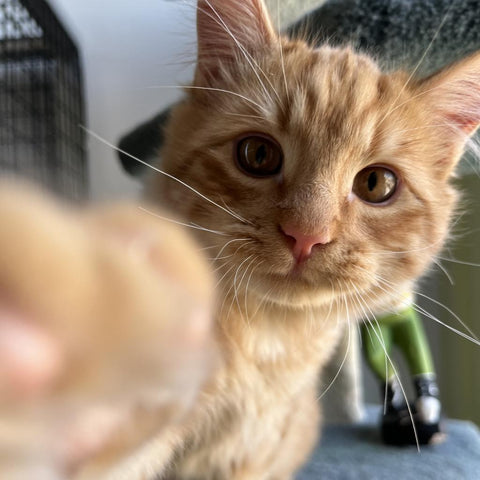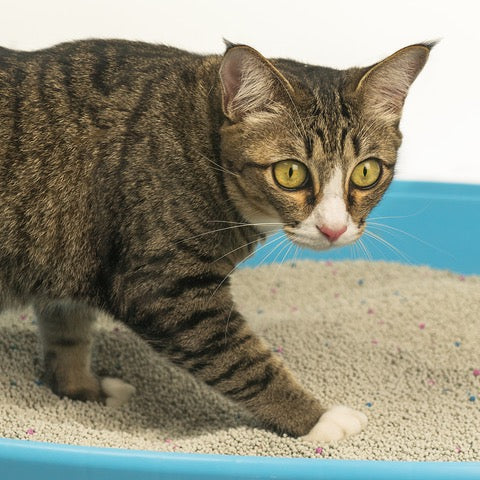Types of cat aggression
Cats make wonderful companions and they often provide a lot of entertainment to their owners, but once in a while cat owners also have to deal with undesirable cat behaviors, such as aggression.
Being able to differentiate between different types of aggression can be very helpful in resolving the issue. For most indoor cat owners, the most common forms of aggression are play aggression, overstimulation and fear or pain aggression. With all forms of aggression it is crucial to never punish a
cat for his or her behavior. There are always reasons behind the aggression and those reasons can be addressed in a positive, constructive way.
First it is important to keep in mind that cats are predators and they have a hunting instinct. You may see this when a cat is playing with toys or chirping at the birds outside the window. This is a completely normal, and in fact, a desirable behavior for any cat. Cat owners should make sure to provide their pets with enough playtime and opportunity to “hunt”. A tired cat with enough mental stimulation is a good cat.
Play aggression
The most common aggressive behavior seen in young kittens and cats is play aggression. Kittens and young cats often play rough with one another. Rambunctious play among kittens is normal and no cause for concern. However, sometimes kittens, especially those who were raised as orphans or without other
kittens to play with, will direct play aggression towards humans. This can include running, pouncing or leaping, but it can also include swatting, scratching and biting. Therefore it is important to teach kittens appropriate play behaviors from a young age.
When kittens play they are learning how to hunt. It is important for human caregivers to help kittens learn appropriate play behaviors. Kittens will find your hands and feet and will want to play with them, and as cute as it is, it can lead to serious behavioral problems as they mature.
Letting kittens play with hands and feet teaches them that putting their teeth on human skin is alright. It teaches them that aggression towards human hands and feet is alright. Cats with aggression are more likely to end up looking for a new home, and less likely to find one. If a kitten wants to play with your hand
while you’re petting her, simply engage them with something that is clearly separate from your body, such as a wand toy or a laser pointer. Once they are tired of hunting, it’s time to pet again!
Overstimulation
Another very common form of aggression is overstimulation. Different cats will tolerate and enjoy different amounts of affection. Some cats enjoy sitting in laps and being held where others are happy with just a pet or two throughout the day. Overstimulation is a normal response to being petted or handled in areas or ways the cat finds uncomfortable or have gone on for too long. Signs of
overstimulation include dilated pupils, flattened ears, hair standing up, twitching skin, chirping, swishing tail, sudden head turn and tense body.
If your cat does become overstimulated, cease play, petting or other interaction with the cat immediately. Continuing to interact increases the risk of aggression. Afterwards, give the cat some time to de-stress and relax in his or her own space. This can take anything from just a few minutes up to a few hours sometimes. If the cat is sitting in your lap when he or she becomes overstimulated, stand up calmly, letting the cat slide off you. If the cat still scratches or bites you, never hit or punish the cat. Avoid situations that you know overstimulate your cat.
Never try to force a cat to be more affectionate than he or she wants to be. If you want to encourage your cat to sit in your lap or next to you, the best way to achieve this is to make it a pleasant, voluntary experience for your cat.
Pain-induced or fear aggression
A form of aggression that can be seen even in cats that are normally affectionate and docile is pain- induced, or fear aggression. Cats that are in pain, stressed out or fearful can hide, stop eating or using the litter box, go outside the litter box or scratch and bite. This can be caused by pain, frustration, new environment or changes in the home. This aggression can be directed towards people, other animals or objects. With this type of aggression the cat may take a defensive posture.
If your cat’s behavior changes, the first thing to do is to make an appointment with your vet to rule out any medical issues. Punishing the cat or becoming angry with the cat will not resolve the issue, but can instead worsen it and lead to other types of aggression.
Other types of aggression
Cats can also exhibit, for example, territorial, maternal, redirected or cat-to-cat aggression. In cases of serious aggression it is always best to consult a veterinarian and a behavioral consultant. For an appointment with a vet or a behavioral consultant, observe your cat’s behavior, when he or she behaves differently than usual and how his or her posture appears. It can help determine a course of action.
Reading your cat’s body language
Signs of an offensive posture include: piloerection, including the tail; constricted pupils; direct stare; growling, howling or yowling; stiff, upright stance with straight legs; tense rear legs, with the rear end raised; stiff or lowered tail; tail held to the ground; upright ears, with the backs rotated slightly forward; facing and/or moving toward opponent. Cat may roll onto his side or back and expose teeth and claws in
preparation for an attack
Signs of a defensive posture include: piloerection; retracted whiskers or panned out whiskers (to assess distance between the cat and the danger); dilated pupils; hissing or spitting; crouching; head tucked in; curved tail tucked in around the body; ears flattened sideways or backward on the head; turning
sideways to the opponent; striking with front paws with claws out. Cat may roll onto his side or back and expose teeth and claws in preparation for an attack.




Comentarios (0)
No hay comentarios todavía. Sé el primero en comentar.